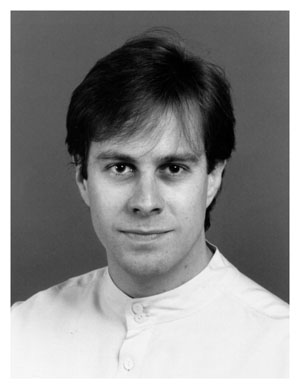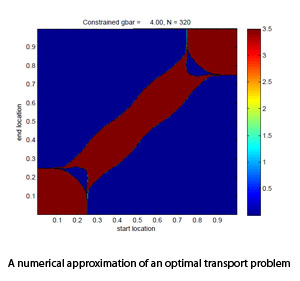PIMS Chats with Robert McCann
Transporting Ideas in Math “I don’t know whether it’s better to say that I chose math or math chose me” says Robert McCann. “Initially I just followed the path of least resistance, but I think that ultimately, it turned out to be the path that fit me best.” In kindergarten, his principal predicted that he would become a mathematician, but his parents concealed this fact from him until he had completed his PhD in math and obtained his first job. “Initially, they might have preferred me to become a medical doctor” he says.
“I don’t know whether it’s better to say that I chose math or math chose me” says Robert McCann. “Initially I just followed the path of least resistance, but I think that ultimately, it turned out to be the path that fit me best.” In kindergarten, his principal predicted that he would become a mathematician, but his parents concealed this fact from him until he had completed his PhD in math and obtained his first job. “Initially, they might have preferred me to become a medical doctor” he says.
Before finding his place with mathematics, he pursued studies in engineering and then physics. “In the second year of my undergrad, we did a fantastic calculation on vibrations and waves. They teach about resonance: if you push a child on a swing at its natural frequency, the child will swing higher, but if you push at any other frequency, it won’t go anywhere.” The class was asked to calculate the resonant frequency of the Bay of Fundy, modelled as a shoebox. “Using trigonometry – sines and cosines – you discover that the Bay of Fundy has a resonant frequency of 12 hours. Since tides go in and out every 12 hours, they are being pushed at just the frequency that they would naturally like to slosh back and forth, which is why it has the biggest tides in the world.”
McCann found this fascinating; that a calculation done with trigonometry could have anything to do with Canada’s natural wonders. “It’s sort of a miracle when you can do a little calculation in your dorm room that reveals something about nature” he says.
Though he was initially attracted to physics, McCann began to realize the beauty and universality of mathematics. “After all, physics only explained a small part of the natural world, but mathematical models also explain things in biology, social sciences, engineering, and more.” The majority of his research is in optimal transportation. He became interested in this topic as a grad student. “I was thinking about rotating stars. The particles swirl around and parts are attracted to each other, which makes it wants to collapse, but they also form a gas, so when those particles try to come together, they pressurize the gas, which leads to an internal energy that pushes outward. The problem I worked on for my thesis was: if you know the total mass, the location of the center of the mass, and the total angular momentum around the centre of mass, what is the minimum energy state that the star can find?” It turns out that unless the angular momentum is zero, there is no minimum energy state.
The majority of his research is in optimal transportation. He became interested in this topic as a grad student. “I was thinking about rotating stars. The particles swirl around and parts are attracted to each other, which makes it wants to collapse, but they also form a gas, so when those particles try to come together, they pressurize the gas, which leads to an internal energy that pushes outward. The problem I worked on for my thesis was: if you know the total mass, the location of the center of the mass, and the total angular momentum around the centre of mass, what is the minimum energy state that the star can find?” It turns out that unless the angular momentum is zero, there is no minimum energy state.
McCann wanted to find stable states for this stellar system. “I needed a metric that was related to transportation of mass.” In the star problem, the issue was minimizing the energy, in the transportation problem, the issue was minimizing the cost; this type of problem is known as the calculus of variations. “It is a very pervasive idea in the mathematical and physical sciences that almost all of the problems in my career have dealt with.”
Optimal transportation is one of the prototypical optimization problems that motivated McCann. As he explains, it can be applied in a variety of models. For example, “In economic problems we try to balance supply with demand, the supply might be mines and the demand factories. Another situation arises in medical student training. Medical students around the country want to get into residency programs and the programs want to fill the available places with the best possible students. The math is applied to pair students with programs, such that you can’t find a student and program who would prefer each other to their current matches.”
“My background is in mathematical physics” he says, “but lately I’ve been working on economic problems, where it is exciting to see that the same kind of revolutionary impact of mathematical ideas which happened in the last century in physics is happening in economics right now.”
He illustrates this by describing work he has done with Young-Heon Kim (UBC), a leading researcher in the recent PIMS Collaborative Research Group in Partial Differential Equations. A main focus in economics is maximizing profits. McCann uses optimal transport to address this. He admits that while the model is a bit idealized, it could be appropriate to describe an issue like Translink (Vancouver’s regional transportation authority) deciding which services to offer and what price to charge to maximize benefit to the population without going broke.
“To formulate this kind of problem” says McCann, “you have to figure out the preferences of your population.” Many factors come into play: speed, cost, comfort, frequency, accessibility. “You conduct market research to determine what the value is to a customer with particular preferences. This information will help you decide what services to offer and how much to charge for each of them.”
“In mathematics, minimization problems are much easier to solve, both theoretically and computationally, if they have a property called convexity – which guarantees that if you change your product line gradually to improve your profits you will eventually arrive at the best situation. We came up with a condition that guaranteed the convexity of this problem; it turned out to involve curvatures. And the reason for that is the same one that led Einstein to general relativity, his geometrical theory of gravity: economics, like physics, should look the same to all observers, independently of how they choose to describe it.”
Robert McCann has been a Professor of Mathematics at the University of Toronto since 1998. He is a leading figure in the development of the theory of optimal transportation. His work balances very pure contributions to deep mathematics with the discovery of new applications to image processing, atmospheric circulation patterns, and to optimizing economic decisions.
His past awards include an American Mathematical Society Centennial Fellowship, the Monroe Martin Prize in Applied Mathematics, and the Coxeter-James Prize of the Canadian Mathematical Society. He currently serves as Editor-in-Chief of the Canadian Journal of Mathematics.
On August, 2012 he delivered a series of PIMS/UBC Distinguished Lectures at the UBC site. Visit Lecture 1 (mathtube.org), Lecture 2 (mathtube.org) and Lecture 3 (mathtube.org) to view the lectures online.